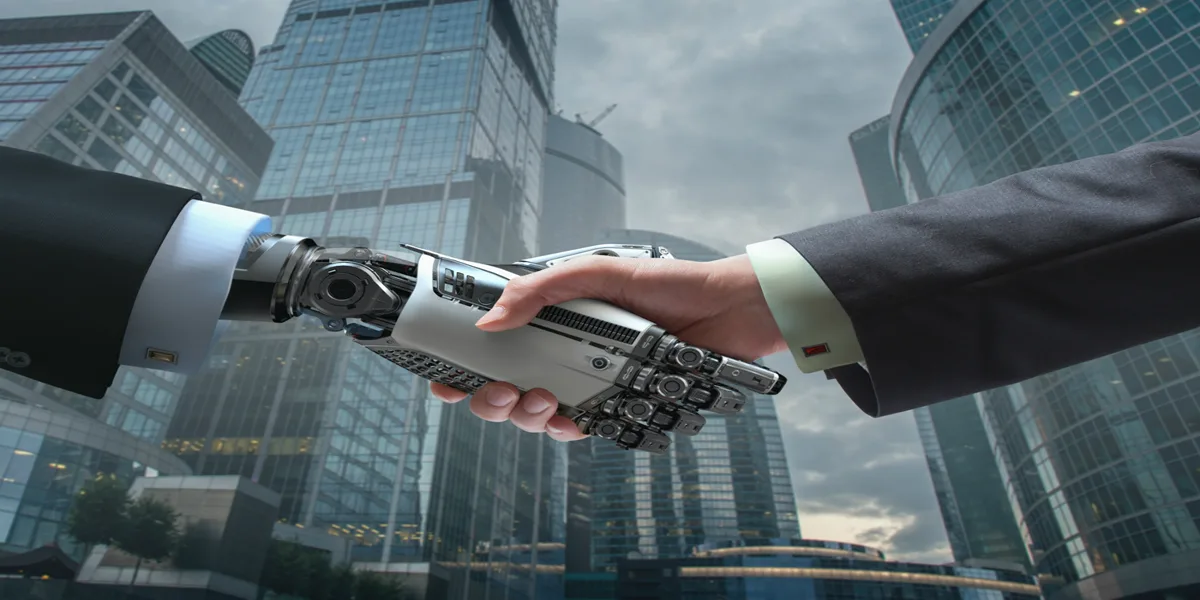7 game-changing ways AI in logistics is revolutionizing the industry

Highlights:
Highlights
- Discover how AI enables real-time route optimization, reducing costs and emissions.
- See how DHL, UPS, and FedEx are using robotics and AI for smarter warehousing and delivery.
- Learn how AI improves demand forecasting and inventory accuracy using real-time data.
- Understand how predictive maintenance extends fleet life and prevents costly breakdowns.
- Explore how AI chatbots like DPD’s Ruby are transforming 24/7 logistics customer support.
Behind each package delivered and every product on a shelf is an intricate choreography of decisions and systems. With supply chains extending across continents and responding to ongoing change, the demand for clarity and control has never been greater. AI in logistics is redefining operational efficiency, decision-making, and supply chain strategies.
In contrast to older models, artificial intelligence facilitates the identification of subtle inefficiencies, predicts changes before they happen, and allows systems to adjust on their own in real-time.
In this blog, we’ll unpack seven transformative ways AI is reshaping logistics, from decision-making to delivery, and how it’s redefining what supply chains can achieve.
AI in logistics: understanding the current transformation
The logistics industry has always been a mirror of the world it transports—fast, volatile, and more interconnected. At the root of today’s transformation is AI in logistics, which is catalyzing the shift from reactive to proactive and dynamic systems.
Historically, route planning was based on fixed timetables and past traffic experience. Warehouse control relied on manual tracking or primitive barcode systems. Disruption response—e.g., delays, stock mismatches, or bursts in demand was frequently sluggish and reactive.
Statista’s recent reports show a world where AI in logistics is working to actually redefine how solutions are overcome and opportunities are made available. Case in point: AI-powered cargo drones are estimated to expand to a $17.88 billion worldwide market by 2030. This marks not only the vision but also the pace of current innovation initiatives.
With real-time data ingestion and processing, AI in logistics can apply continuous route optimization using live traffic, weather, and shipment data. Machine learning algorithms use historical trends in conjunction with real-time inputs to make better demand predictions and adjust inventory levels accordingly. In warehousing, computer vision and robotics with AI enable autonomous picking, sorting, and inventory monitoring, eliminating human error and increasing throughput.
Smarter demand forecasting and inventory optimization
One of the most significant ways AI in logistics is reshaping operations is through more intelligent demand forecasting and inventory management.
Conventional approaches—based heavily on manual data input, past sales patterns, and departmental inputs in silos fail to keep up with the growing volatility and complexity of today’s markets.
AI-powered systems improve precision by analyzing huge amounts of structured and unstructured data, detecting intricate patterns, and creating predictive models that adapt dynamically to real-time inputs. These models integrate variables like weather conditions, social sentiment, economic factors, and competitor behavior, which conventional systems tend to miss.
A leading example of AI adoption in demand planning is Nestlé’s demand management revolution. Nestlé applied advanced statistical forecasting and machine learning techniques to enhance its demand sensing and shaping capabilities. It moved away from decentralized planning procedures to an integrated, AI-enabled platform that supports real-time collaboration across functions.
AI capabilities in Nestlé’s platform learn from forecast errors in real-time, enhance the accuracy of models over time, and automatically identify anomalies. This frees planners from point-to-point forecasting to address strategic exceptions and value-added analysis.
Automating warehousing and distribution processes
Besides demand forecasting, AI implementation in warehousing and distribution operations is a revolutionary shift from static rule-based processes to adaptive self-optimizing procedures. Traditional warehouse designs rely on pre-programmed processes, human monitoring, and reactive decision-making.
AI in logistics, however, utilizes real-time processing of data, predictive analytics, and machine learning algorithms to carry out complex tasks such as inventory management, route planning, and picking.
Artificially intelligent (AI) powered Warehouse Execution Systems (WES) and Autonomous Mobile Robots (AMRs) have the ability to adapt dynamically to changing patterns of demand. They also offer real-time inventory visibility, slashing human error and operational latency significantly.
One of the most sophisticated uses of AI in warehouse automation comes from DHL’s “We, Robot” initiative. DHL is using AI-powered robotic arms and cobots (collaborative robots) to handle jobs such as kitting, sorting, and palletizing — jobs that are high-touch, error-prone, and repetitive when done by humans.
For instance, DHL’s partnership with Dorabot has led to the implementation of “DHLBots,” which sort over 1,000 packages an hour with 99% accuracy. These robots use computer vision and AI to detect and process packages efficiently, while exception handling and maintenance are handled by humans.
Similarly, DHL’s pilot with Boston Dynamics’ ‘Stretch’ robot demonstrates AI’s capacity to intelligently analyze, prioritize, and unload containers. This was a task that previously required hours of manual labor.
Whereas traditional systems are linear and task-oriented, AI in logistics brings flexibility, adaptability, and intelligence to logistics operations. In traditional warehousing, human operators undertake repetitive work and address problems reactively, frequently leading to congestion during peak times. Automation through AI provides an alternative to this with data-driven decision-making and robotic precision.
Read more: Global logistics automation market: Growth opportunities, challenges, and key trends
Improving real-time tracking and supply chain transparency
Visibility and real-time monitoring throughout the supply chain is of extreme significance in logistics. AI in logistics is instrumental in bringing these capabilities to the forefront.
Legacy supply chains relied on intermittent status messages, labor-intensive reports, and isolated data systems, producing latency and poor visibility. In contrast to this, AI-powered tracking systems integrate data streams from IoT sensors, GPS, and the cloud into a single, real-time view of products in transit.
These systems not only track the movement of goods and vehicles but also analyze trends, detect anomalies, and predict disruptions. With this level of transparency, logistics providers can advance-respond to problems such as delays, route deviation, or temperature breaches in cold chain logistics, rendering operations more reliable and smoother.
One of the finest cases in point is Rolls-Royce Power Systems “Internet of Engines” initiative. Faced with astronomical costs in terms of unexpected engine downtime in marine and mining industries, Rolls-Royce developed a low-cost, AI-powered IoT tracker capable of monitoring the position, operating time, and performance of engines across six continents. The trackers report real-time data in the form of GSM into cloud platforms even from distant locations.
Breaking silos for better orchestration and visibility
Thus AI logistics not just combines several streams of data, it also breaks silos of information between customers, carriers, and suppliers, and enables end-to-end supply chain orchestration. Firms gain competitive advantage in the form of improved delivery accuracy, improved risk mitigation, and more accurate inventory control.
Additionally, yesterday’s supply chains relied on intermittent status messages, manual reports, and separate data systems, which introduce latency and poor visibility.
In contrast to this, AI-driven tracking systems integrate IoT sensor streams, GPS, and cloud data into a single, real-time view of products in transit. These systems not only track the movement of vehicles and shipments but also analyze patterns, identify anomalies, and predict disruptions.
This level of transparency enables logistics providers to advance-respond to problems such as delays, route deviations, or temperature breaches in cold chain logistics. This enhances operations to be more reliable and smoother.
Optimizing transportation routes and delivery efficiency
As mentioned earlier, real-time responsiveness is among the primary benefits of AI in logistics. With intelligent route calculation of the shortest routes and best vehicle capacity usage, AI in logistics helps firms minimize operating costs and carbon emissions in response to increasing demands for sustainability within logistics.
The strong emphasis on the use of real-time data in AI-driven route optimization reflects a significant change from static planning to highly dynamic real-time adjustments in logistics.
The benefits of reduced fuel usage and decreased empty miles translate into both significant cost reductions and greater environmental responsibility for logistics activities.
A great example is UPS’s dynamic ORION system, which dynamically updates delivery routes throughout the day based on changing conditions. This AI-based enhancement has cut 2–4 miles per driver per day on top of the original 8-mile decrease over its prior version.
It enables UPS to respond in real-time to new pickups and interruptions, conserving carbon emissions and enhancing last-mile delivery efficiency. This real-time data-driven routing is a shift from static planning to real-time decision-making.
AI in logistics routing application goes beyond external deliveries to internal operations in distribution centers and manufacturing facilities, minimizing mistakes and enhancing overall efficiency. AI has transformed route optimization through the use of real-time traffic flows and creating consistent travel time forecasts, drastically enhancing last-mile delivery efficiency and overall supply chain responsiveness.
The capability of AI to integrate live information seamlessly allows real-time rerouting in case of unforeseen circumstances such as traffic accidents or abrupt weather changes.
Implementing predictive maintenance for fleet and equipment
One of the leading examples of AI in logistics is the partnership between Daimler Truck North America (DTNA) and Uptake Technologies, which is revolutionizing fleet maintenance by leveraging sophisticated AI integration. Their Uptake Fleet platform employs machine learning models to track and analyze the performance of critical vehicle subsystems in real time.
These AI models evaluate data from numerous sensors and operational histories to recommend actionable, timely interventions. This reduces unplanned downtime, optimizes part utilization, and synchronizes maintenance schedules with true component wear. The outcome is not only expense savings, but also extended asset lifespans and increased fleet reliability.
Conventional fleet maintenance practices are based on fixed service schedules or reactive repair following breakdowns. Such a strategy tends to result in either premature servicing at unnecessary costs or expensive unexpected breakdowns, which interfere with logistics operations and raise total cost of ownership. These inefficiencies highlight the limitations of schedule-based maintenance in high-speed, asset-heavy logistics operations.
AI-driven predictive maintenance in logistics is realized through integrating telematics, IoT sensors, edge computing, and machine learning algorithms. Machines and vehicles are installed with a range of sensors tracking a wide set of parameters—e.g., engine temperature, vibration patterns, fuel efficiency, tire pressure, braking performance, oil condition, and GPS coordinates.
These data streams of high frequency are fed into predictive algorithms that have been trained on historical maintenance records and real-time usage conditions, allowing AI to identify anomalies and patterns of deterioration well ahead of any mechanical failure.
Logistics AI therefore marks a shift from reactive to proactive vehicle maintenance, enabling operations to be more robust, cost-effective, and sustainable.
Autonomous last-mile delivery with AI in logistics
Perhaps the most revolutionary application of AI to logistics is autonomous last-mile delivery. It is now possible for AI technology to traverse high-density city centers, dynamically decide in real time, and safely interact with other road users and pedestrians. This robotics resolves significant logistics issues such as speed of delivery, efficiency, and expense—especially in dense locations.
A good example is Roxo™, the FedEx SameDay Bot, which is for short-range, autonomous delivery. Roxo uses AI technologies such as computer vision, sensor fusion, and machine learning to travel on sidewalks, curbs, and even stairs up to a three-to-five mile radius surrounding retail outlets.
It also has 360-degree sensors and is supported by remote human operators who can intervene if the situation requires it. Roxo is an excellent example of how logistics is using AI not only for automated delivery but also enhancing safety, responsiveness, and sustainability with zero-emission smart solutions.
Roxo is a fine example of how logistics is tapping AI for not just automated delivery but enhancing safety, responsiveness, and environmental friendliness with zero-emission smart solutions.
With growing pressure for speed and touchless delivery, the likes of Roxo highlight the growing role of AI in logistics in customer-focused last-mile delivery operations.
Revolutionising customer support with AI-powered chatbots
Finally, AI in logistics isn’t just about optimizing processes such as demand planning or routing. It’s also having a major impact on enhancing customer service with intelligent chatbots and virtual assistants offering real-time feedback and assistance.
Customer service in traditional logistics relied heavily on call centers, email exchanges, and manual lookup of statuses. These processes are labor-intensive and time-consuming. Response times were inconsistent, and visibility into real-time shipment status was poor, enraging customers and creating operational backlogs.
Chatbots driven by AI avoid such headaches by offering 24/7 chat assistance, answering immediate queries about shipment status, delivery time, return procedures, and availability. These are fueled by NLP and machine learning, enabling them to understand context, learn from past interactions, and present human-like, intelligent responses.
In contrast to early scripted bots, today’s AI-driven assistants have the ability to escalate problems if needed, provide delivery time recommendations, or even assist with rerouting packages according to client preference.
One standout example
‘Ruby’, the self-improving chatbot that DPD recently introduced. It is an upgrade from their earlier bot, ‘Phil,’ and represents a significant improvement in customer experience.
It gets better with time as it learns from previous conversations. This enables it to provide highly relevant, dead-on responses to queries such as “When will my parcel be delivered?” or “Where is the nearest pickup parcelshop?”—through text, suggested choices, or even voice input.
Accessible on both desktop and mobile devices, Ruby is capable of handling delivery alterations, finding parcel shops by geolocation, and directing users to their myDPD account for more complex actions. And if Ruby is unable to solve a problem instantly, it smoothly escalates to FAQs or live support.
Furthermore, DPD intends to integrate Ruby into backend systems like CRM systems and shipping software, making it possible for customers to order shipments via the chatbot. This is the ultimate example of AI in logistics marrying operational automation with customer-facing innovation.
With rising volumes of e-commerce and escalating customer expectations, smart chatbots such as Ruby provide logistics operators with a scalable means to tailor communication. This helps decrease support expenses, and increase customer satisfaction, all while learning and maturing over time.
Conclusion
The use of AI in logistics is naturally reshaping supply chains across most fundamental functions. From enabling smarter demand planning and stock optimization to automation of warehousing and distribution, the influence of intelligent automation is noteworthy.
AI’s ability to enable real-time tracing and provide unmatched supply chain visibility provides time-sensitive decision-making and risk evasion. In addition, optimization of transportation routes and the attendant increased delivery efficiency is reducing costs while improving sustainability.
The use of predictive maintenance for equipment and fleet guarantees reliable operation and prolongs the life of valuable assets. Lastly, AI in logistics is transforming customer service and communication by offering customized, effective, and 24/7 support. The overall impact of AI in logistics on supply chains is characterized by higher efficiency, tangible cost savings, better customer satisfaction, and increased resilience amid a constantly changing global environment.
AI is an unavoidable reality for logistics companies to survive and thrive in a tough and rapidly evolving business climate. Prepared to harness the game-changing power of AI in logistics for your company?
Contact Netscribes now and discover how our tailored AI business solutions can help. Learn how we can help your company optimize its supply chain for improved efficiency, strength, and general success.






